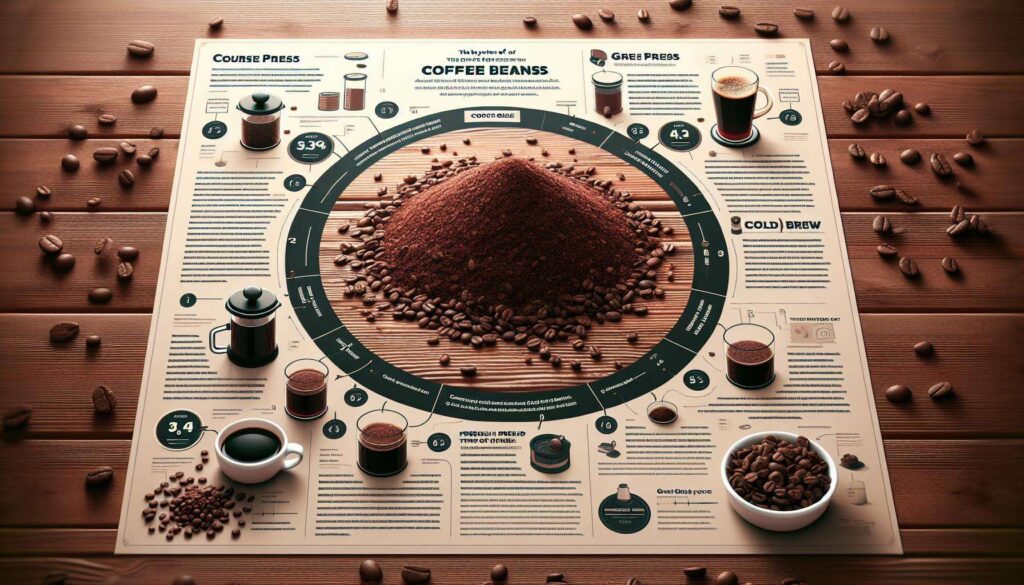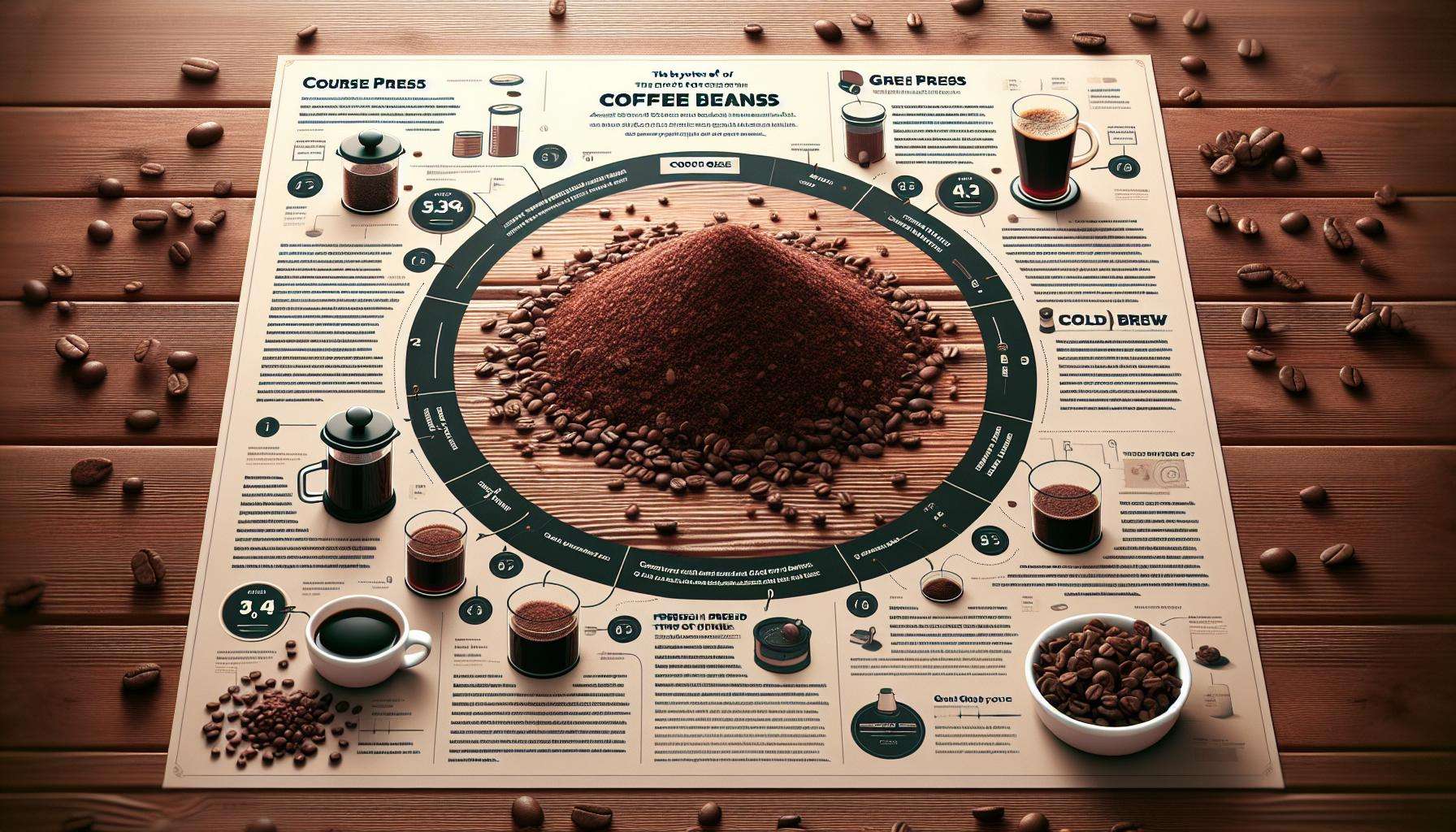
What Does Coarse Ground Coffee Look Like? A Visual Guide for Coffee Enthusiasts
The world of coffee is a vast and nuanced landscape, with seemingly endless variables impacting the final cup. From the origin of the bean to the roasting process, each step plays a crucial role. However, one of the most fundamental aspects of coffee preparation, often overlooked, is the grind size. Understanding how different grind sizes affect extraction is paramount for achieving the perfect brew. This article delves into the visual characteristics of coarse ground coffee, providing a comprehensive guide for coffee lovers seeking to elevate their brewing game. The question, “What does coarse ground coffee look like?” is more than just a curiosity; it’s a key to unlocking better coffee.
The Importance of Grind Size
Grind size is a critical determinant of extraction. Extraction is the process by which water dissolves the soluble compounds from the coffee grounds, resulting in the flavorful beverage we know and love. If the grind is too fine, the water will extract too many compounds, leading to a bitter, over-extracted brew. Conversely, if the grind is too coarse, the water will extract too few compounds, resulting in a sour, under-extracted brew. Coarse ground coffee, therefore, plays a specific role in the brewing process, particularly for methods that require longer brewing times and coarser grounds.
Visual Characteristics of Coarse Ground Coffee
So, what does coarse ground coffee look like? The visual appearance is a key indicator of its suitability for specific brewing methods. Here’s a detailed breakdown:
- Texture: Coarse ground coffee has a noticeably chunky texture. The individual particles are easily discernible, and the coffee feels less like a powder and more like small, irregular fragments. This is a stark contrast to the fine, almost powdery texture of espresso grounds.
- Size: The individual particles of coarse ground coffee are significantly larger than those of finer grinds. Think of the size of sea salt or even slightly larger. This size is crucial for allowing water to flow through the grounds without obstruction, a key factor in brewing methods like French press and cold brew.
- Color: The color of the grounds can vary depending on the roast level of the beans, but generally, coarse ground coffee will retain a slightly more granular appearance than finer grinds. The color itself isn’t a defining characteristic of the grind size, but the way light reflects off the larger particles can offer a visual clue.
- Shape: The shape of the particles is irregular. Unlike the uniform fineness of espresso grounds, coarse grounds have varying shapes and sizes, reflecting the fracturing process during grinding.
Comparing Coarse Grinds to Other Grind Sizes
To better understand what coarse ground coffee looks like, it’s helpful to compare it to other grind sizes:
Coarse vs. Extra Coarse
Extra coarse is the largest grind size, often used for cold brew. It will look even chunkier than coarse, with particles resembling coarsely cracked peppercorns. Coarse ground coffee is slightly smaller than extra coarse, but still retains a significant particle size.
Coarse vs. Medium
Medium grind is the standard for drip coffee makers. It’s finer than coarse, with a texture similar to coarse sand. The particles are smaller and more uniform compared to coarse ground coffee.
Coarse vs. Fine
Fine grind is used for espresso and some pour-over methods. It has a powdery texture, similar to table salt. The particles are significantly smaller than those of coarse ground coffee.
Coarse vs. Extra Fine
Extra fine is the finest grind, resembling a powder. It’s typically used for Turkish coffee and can be challenging to work with if not properly managed. The difference between coarse ground coffee and extra fine is immediately apparent.
Brewing Methods Best Suited for Coarse Ground Coffee
Understanding the visual characteristics of coarse ground coffee is only the first step. Knowing which brewing methods utilize this grind size is equally important. The following methods are ideally suited for coarse grounds:
- French Press: The French press relies on immersion brewing, where the coffee grounds steep in hot water for several minutes. Coarse grounds are perfect for this method, allowing for a full-bodied, flavorful cup without over-extraction.
- Cold Brew: Cold brew is another immersion method, but with cold water and a much longer brewing time (12-24 hours). Coarse grounds are essential for cold brew, preventing the grounds from passing through the filter and creating a muddy brew.
- Coffee Cupping: Coffee cupping, the professional method for evaluating coffee, often uses a coarse grind. This allows for a clear assessment of the coffee’s aroma, flavor, and body.
- Some Percolators: Certain percolator models benefit from a coarser grind. However, it is important to check the manufacturer’s recommendation for the specific percolator being used.
Grinding Your Own Coffee: A Key to Quality
While pre-ground coffee is convenient, grinding your own beans immediately before brewing is widely considered the best way to achieve optimal flavor. The oils and aromas that give coffee its character start to degrade quickly after grinding. For coarse ground coffee, a burr grinder is highly recommended. Burr grinders use two revolving abrasive surfaces to crush the beans, resulting in a more consistent grind size than blade grinders, which chop the beans into uneven pieces. The consistency of the grind is crucial for even extraction, ensuring a balanced and flavorful cup. The difference in quality is noticeable, and understanding how to achieve a consistent coarse grind is vital.
Troubleshooting Coarse Grind Issues
Even with a burr grinder, achieving the perfect coarse grind can take practice. Here are some common issues and how to address them:
- Uneven Grind: If your grind is inconsistent, with some particles much larger or smaller than others, it can lead to uneven extraction. This can result in a bitter or sour taste. Ensure your grinder is clean and properly calibrated. Experiment with different grind settings to find the sweet spot.
- Too Coarse: If your coffee tastes weak or sour, the grind may be too coarse. Adjust the grinder to a finer setting and try again.
- Too Fine: If your coffee tastes bitter or overly strong, the grind may be too fine. In this case, adjust your grinder to a coarser setting.
Visualizing the Perfect Brew
Ultimately, understanding what coarse ground coffee looks like is a crucial step in becoming a better home barista. By paying attention to the visual characteristics of the grounds and matching them to the appropriate brewing methods, you can unlock a world of flavor and consistently brew exceptional coffee. The journey from bean to cup is a rewarding one, and the ability to identify and utilize the correct grind size is a cornerstone of that journey. From French presses to cold brew, the correct grind is essential to a great cup. The appearance of the grounds, the aroma they give off, and the brewing method all work together to create a truly enjoyable experience. This guide aims to give you the knowledge to achieve a better brew by appreciating the visual cues of coarse ground coffee.
Conclusion: Mastering the Coarse Grind
Mastering the art of coffee brewing requires a keen understanding of numerous factors, and the grind size is undoubtedly one of the most critical. Knowing what coarse ground coffee looks like and how to use it effectively is a fundamental skill for any coffee enthusiast. By using this knowledge, you can consistently brew delicious coffee using methods like French press and cold brew, and truly appreciate the nuances of your favorite beans. The next time you are preparing coffee, take a moment to examine the grounds. The visual clues they provide will guide you towards a more flavorful and satisfying cup. The visual characteristics of coarse ground coffee are the gateway to a world of coffee excellence.
[See also: How to Choose a Coffee Grinder, Best French Press Coffee Recipes, Cold Brew Coffee Guide]


